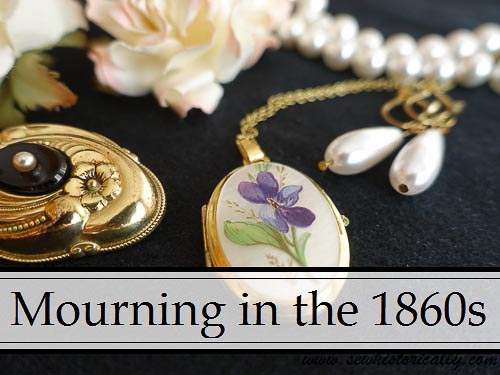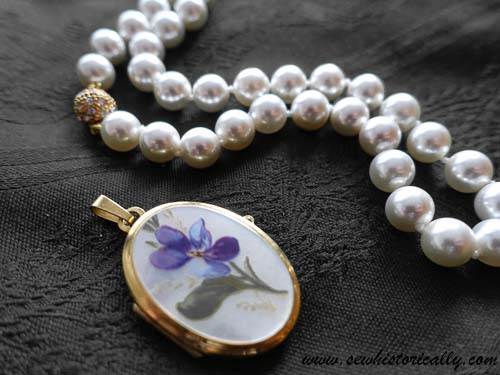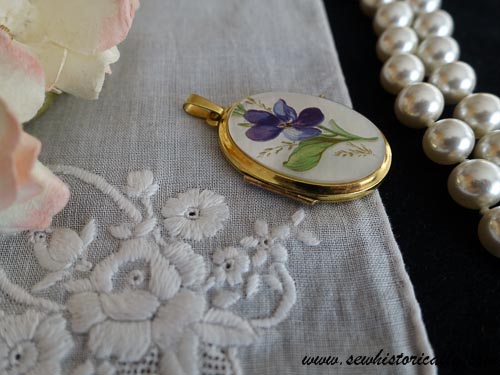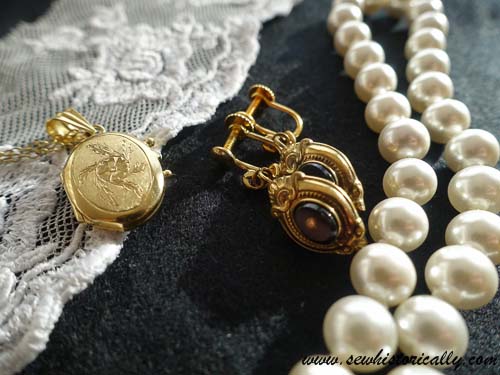Three stages of mourning were worn in the 1860s: Close or deep mourning for the nearest relations. Second mourning for distant relatives or by those who have previously worn deep mourning. Slight or half-mourning was the third mourning stage before mourners returned to wear ordinary dress. Each stage had its own requirements. It was a social obligation to follow the mourning etiquette in order not to become a social outcast.
Be aware that the mourning etiquette in America is less rigid than in England (some of my sources are US and some English) (Godey’s Lady’s Book, 1854).
Deep mourning
Dress
For deep mourning: Lusterless black fabrics, such as bombazine, grenadine, crape, barège; crape bonnet with crape veil ‘kept in place by long jet clasp pins’ (Godey’s Lady’s Book, 1862). Bombazine is less worn in 1864, but rather Henrietta cloth, Barathea, wool delaines, and merino; for summer: grenadine. In ‘deep mourning no trimming is used’. Shawls of silk grenadine trimmed with crape or silk; for colder weather: fine black Thibet (wool) shawl trimmed with crape or silk. Bombazine, crape, and crape-covered silk bonnets. (Godey’s Lady’s Book, 1864)
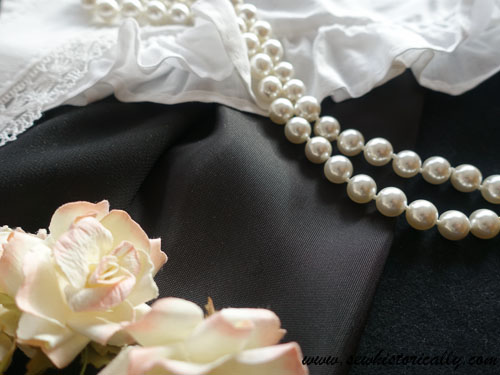
1861 black barege or grenadine dress with tiny flounces, a shawl of the same material, and ‘a black crinoline bonnet, trimmed inside and out with branches of black lilac’ (The Englishwomen’s Domestic Magazine, 1861). ‘The plain black worsted cord is much used for the trimming of mourning dresses’ (Godey’s Lady’s Book, 1866, p. 104).
Pictures, photographs and paintings
1860s photograph of a young widow. 1865 photograph of woman mourning for her father. 1860s photograph of woman with mourning veil over her face. Photograph of two ladies in mourning.
1861 painting of a young widow. 1860s painting of a widow.
Mourning clothes can be ordered per mail: ‘mourning goods from Besson & Son’ (Godey’s Lady’s Book, 1864).
Bonnets, caps and accessories
1860s crape covered bonnet; mourning bonnet with deep mourning veil. 1858 netted mourning cap. 1872 mourning cap for elderly woman. 1870s white mourning indoor caps.
Crape covered mourning parasol.
Second mourning
Dress
‘There is no dress that requires more discretion in the choice and arrangement than that called second mourning, but it is one of the most elegant, when well selected.’ (Godey’s Lady’s Book, 1864)
Pictures and photographs
1860s shiny black silk gown.
A woman who had lost her son ordered from her dressmaker for herself and her two grown-up daughters three bombazines, three alpacas, and three black calico dresses (Godey’s Lady’s Book, 1863).
Ca. 1864 photograph of a widow in short demi-veil, bonnet with white quillings. 1860s photograph of mother and child in mourning. Victoria and her daughters in crape trimmed mourning dresses. Victoria in a 1862 mourning dress of dull fabric and demi-veil. Victoria in crape-trimmed dress, dull black coat and widow’s cap with demi-veil. Ca. 1863 photograph of a woman in second mourning. Another photograph of a lady in second mourning. Ca. 1862 photograph of a lady in dull black gown, black cap, and shiny black leather gloves. Photograph of widow in second mourning with shortened veil and some shiny fabric. Photograph of woman with longer demi-veil and shiny bonnet ties. 1861 painting ‘In Memoriam’ of a widow wearing a demi-veil. Painting ‘In Memoriam’ of a widow and two other ladies. Painting of a widow in shiny black dress.
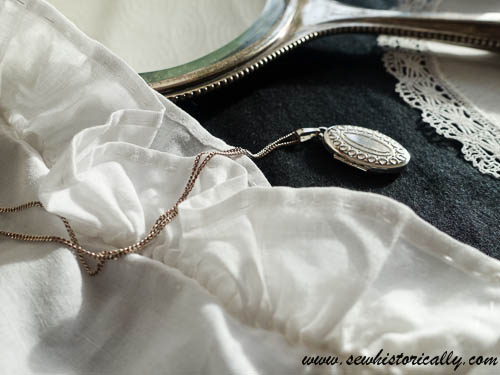
Accessories
Two black lace day caps with jet beads.
1866 mourning fan, ‘edged with black feathers’ (Godey’s Lady’s Magazine, p. 440).
Half-mourning
Dress
Some colour may be added, such as pearl, grey, lilac and purple. Dresses may be trimmed with flounces, gathered ribbons and ruches edged with lace (Godey’s Lady’s Book, 1862) Black grenadine dress trimmed with frills and silk; dresses and trimmings in black, grey and lavender. Alpaca trimming on the skirt. Shawl of black grenadine trimmed with white and violet striped border and silk fringe. Lusterless silk basquines without trimming. Black tulle bonnet trimmed with violets. ‘White crape bonnet covered with black lace and trimmed with violet flowers and violet strings’ for afternoon half mourning wear. Sheer devoré bonnet trimmed with black ivy leaves, and white and black flowers, and with white strings. (Godey’s Lady’s Book, 1864)
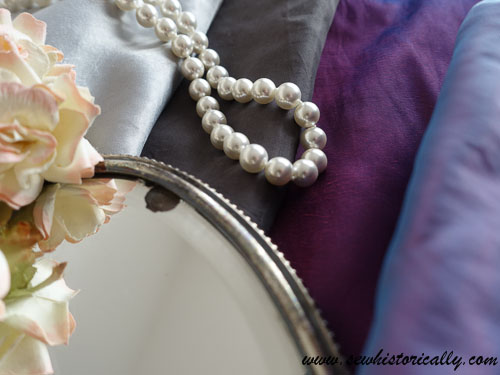
Dress for slighter mourning: ‘a black silk dress with five narrow flounces at the bottom, edged with lilac silk; a black silk mantle, trimmed with lace, and a pelerine; and a white tulle, or crepe bonnet, bound with black velvet, trimmed outside with a black and white rosette, or a bunch of black and white feathers, and inside with a bandeau of violets’ (The Englishwomen’s Domestic Magazine, 1861).
Pictures and fashion plates
1860s black and purple half-mourning dress. 1860s grey and lavender half-mourning dress. 1860s grey and black half-mourning dress. 1869 grey silk dress.
1865 fashion plate with black and purple dress. 1866 half-mourning dress of grey taffeta trimmed with black velvet ribbon and closed on the front with mother-of-pearl buttons (figure in the middle of the second image).
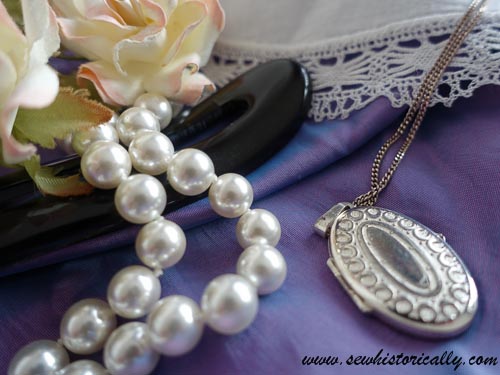
Bonnet and accessories
1866 half mourning bonnet: front border and curtain of white chip, crown of black tulle, trimmed with black velvet ribbon, white chalk beads (Godey’s Lady’s Book, p. 109). Half-mourning bonnet of black straw trimmed with purple silk. 1865- 70 half-mourning bonnet in purple and white.
White linen mourning handkerchief embroidered with black silk.
1871-2 gold locket with hair. 1860 gold mourning ring with black enamel. 1870 black jet earrings. 1860 gold mourning bracelet with black enamel, diamonds and pearls. 1870 jet mourning bangle. 1870 jet mourning brooch. 1875 jet brooch. 1860s gold brooch with pearls and black enamel.
1862 jet and steel mourning fan with black lace over white silk (Godey’s Lady’s Book). Picture of mourning fan.
How long should one mourn?
- husband or wife: 1-2 years, or life-long
- parent, grandparent, children (above ten years of age): 6 months – 1 year
- siblings: 6-8 months
- uncles, aunts, children (under ten): 3-6 months (photograph of mother in mourning for her child)
- cousins, uncles and aunts related by marriage: 6 weeks – 3 months
- infant: 6-7 weeks
- distant relatives and friends: 3 weeks or more
(The Bazar Book of Decorum: The Care of the Person, Manners, Etiquette, and Ceremonials, 1870)
